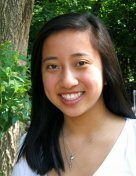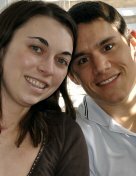There was a sliver of a chance, maybe, and most likely the emergency room doctor thought there was no chance at all. Christine had arrived at the community hospital comatose, brought by her parents, who had come home after working out to find her semi-conscious on the floor. A CT scan revealed severe bleeding in her brain, the result of an aneurysm that had ruptured and spilled into a tangled mass of arteries. The abnormalities in her brain had probably been present since birth. On this particular Saturday evening, they presented in a sudden and unexpected catastrophe.
The emergency room physician advised Angie, Christine’s mother, to call the family together to say goodbye. Christine, only 15 years old, was unlikely to live more than another hour.
Angie refused to believe it. Only a few hours ago, on the Saturday before Thanksgiving in 2007, her daughter had been an athletic and perfectly healthy teenager. Angie, who had endured a harrowing escape as a Vietnamese refugee, had seen death, and this was not what death was supposed to look like. Death looked like pirates taking over a ship, slashing and plundering. Death looked like 14 days without food. Death did not look like a 15-year-old who excelled in high school and played on the tennis team.
In a series of fortuitous events, Angie was able to reach the only person she knew to call, a Vietnamese-American neurologist from Louisiana, Benjamin Nguyen, M.D., a UC College of Medicine graduate who was a friend of her brother’s. “He and his family were going on a holiday ski trip in Denver,” Angie recalled. “I was very lucky to get hold of him at that very moment, because if I had called him 15 minutes earlier he would have still been on the plane, and if I had called him 15 minutes later he would have been in the mountains, where there was no connection.”
Dr. Nguyen asked Angie to open one of Christine’s eyelids and see whether the pupil showed any sign of movement. “I said, yes, it moved a little,” Angie recalled. Dr. Nguyen then told her to have Christine rushed to surgery. With that, Christine’s parents begged the doctors to transfer her to Cincinnati Children’s Hospital Medical Center.
“I said as her mother I wanted to fight for the 1 percent chance that she would live,” Angie said. “The emergency room doctor was concerned that she wouldn’t survive, and that if she did she would be left in a vegetative state. I said I would deal with the vegetative state later.”
The emergency room doctor consented, and a helicopter was summoned.
With Christine on board and the helicopter in mid-air, another stroke of luck abetted Christine’s survival: a quick-thinking young neurosurgical resident, Ondrej Choutka, M.D., viewed her brain scan online through the Healthbridge system, which unifies hospital computer systems throughout the Tristate. Struck by the size and location of the hemorrhage, Dr. Choutka suspected a vascular malformation and knew the patient would be best served at University Hospital. He called the flight physician, Bill Hinckley, M.D., an emergency medicine physician who, together with his resident, Orlando Encarnacion, M.D., was stabilizing Christine’s condition in flight, and asked them to divert the helicopter to University Hospital, renowned for its UC Neuroscience Institute and ground zero for the Greater Cincinnati/Northern Kentucky Stroke Team.
Dr. Choutka then summoned Todd Abruzzo, an interventional neuroradiologist with UCNI and the Mayfield Clinic, and Mario Zuccarello, M.D., a neurosurgeon with UCNI and Mayfield and Chairman of the UC Department of Neurosurgery. Christine was wheeled into the neuroangiography suite at 11 p.m. and, over the next five hours, the neuro-interventional team stopped the bleeding and saved her life.
Christine’s remarkable story is made more so by her recovery. After missing 108 days of school following her stroke, she spent two years catching up. And in the spring of 2010, she graduated with distinction from her high school.
Christine was home alone when the headache struck in the early evening of Saturday, Nov. 17, 2007. “Our parents were out exercising, and my sister had left for an event at our school,” Christine said. “I turned on the TV, and as I turned it on I had a horrible headache. I thought, oh my God, it was so painful. I called a friend and she told me to take ibuprofen and lie down. Then I called my sister and she said the same thing: go lie down.”
Nauseated, Christine staggered to the bathroom and threw up. She was aware that she couldn’t raise her right arm to flush the toilet. “I felt so dizzy and nauseated and fatigued,” she said. “I thought I would lie down on the floor with my head in the hallway so that my parents could see me when they came home. I didn’t feel any pain. I just drifted.”
When Christine’s parents arrived, they thought at first that she had suffered food poisoning, which their other daughter had experienced a few weeks earlier. But Angie noticed that Christine’s leg was cold. “I thought this is not a regular food poisoning. I said we need to take her to emergency. Her heart beat was slow, her lips were pale.”
At the hospital, clinicians asked whether Christine had vomited – a classic sign of stroke -- then ordered the CT scan.
Later, at University Hospital, Dr. Choutka began the neuro-interventional process by shaving a little strip of Christine’s hair, then drilled a small hole to help relieve pressure caused by swelling. “Christine was actually herniating from hydrocephalus, a buildup of spinal fluid, as a result of the large hemorrhage,” Dr. Choutka said. “The pressure was relieved through a small catheter placed at the bedside through a hole drilled into her skull.”
Christine would be very pleased later that he hadn’t shaved her entire head. When Angie asked him, “Why do you pay attention in emergency to the beauty of the woman?” he replied: “First, I don’t have time to shave her whole head. And second, I do really care about the beauty of a young girl. When she wakes up, she will see herself and I want her to feel happy and optimistic about her future.”
Following placement of the catheter in her skull, Christine was taken to the neuroangiography suite, where Dr. Abruzzo obliterated the aneurysm within the AVM to prevent bleeding from recurring. He inserted a catheter into Christine’s groin and deftly navigated it up to her brain. He then stopped the bleeding by injecting the AVM with Onyx, a liquid agent that solidifies upon contact with blood. Christine did not undergo surgery, Dr. Choutka said, because of the AVM’s location in her brain. “She would have been devastated by any surgical approach,” he said.
The team finished the neuro-interventional procedure at 4 a.m. At 7 a.m., Dr. Abruzzo was back at the hospital, checking on Christine to see whether she would require additional treatment. With Dr. Abruzzo at the bedside, Angie asked Christine to squeeze Dr. Abruzzo’s hand if she recognized the doctor who had helped save her life the night before. Though in a coma, Christine squeezed his hand. Dr. Abruzzo’s eyes filled with tears, and Christine’s mother knew a turning point had arrived. Her daughter had survived.
Other turning points occurred after Christine woke up and repeatedly asked her mother and grandmother for a glass of lemonade. But every time they offered her the lemonade, she refused. What she really wanted, her sister finally realized, was for someone to turn on Grey’s Anatomy. Inch by inch, Christine fought her way back from aphasia (the inability to talk) and hemiplegia (the inability to move one side of her body.)
“The months following my aneurysm were the most trying period of my life,” Christine wrote in her college essay. “I couldn’t walk, eat or go to the bathroom on my own. Taking a shower required two extra people. I was like a baby again. In addition to my new physical handicaps, I also had trouble finding words and communicating.”
Christine’s AVM was treated with radiation, and six months after her stroke, as her faculties continued to improve, she was able to speak to her class about her brain injury and her recovery. Supported and encouraged by her family, friends, community and school, Christine inched her way back. She was eventually able to play tennis again, get her driver’s license, and throw herself back into her studies. And in a crowning moment of her re-assimilation into daily life, she was elected senior class co-president at her high school.
Graduating with her class was no small feat. She had missed 108 days of school during her sophomore year and had attended only part-time during her junior year because of the demands of physical and speech therapy. To compensate, she spent two summers immersed in her studies, working through the weekends and at night to catch up.
“I have a crooked smile and a scar on my head to remind me of that November night,’’ her college essay concluded, “but I also have the knowledge that I am capable of achieving anything I set my mind to.”
Her mother, meanwhile, lives “with the perspective of acceptance and gratitude of what happened” and is “forever grateful for the doctors and nurses.” Her father, in a parallel neurological drama, is confronting early-onset Parkinson’s disease. And her sister, hit hard by these twin calamities, has charted a career path in neuroscience, with the aim of becoming a physician who helps people who suffer from neurological disease.
Christine will undergo a followup angiogram in February 2011, three years after her first radiation treatment. “If her AVM has shrunk completely,” Dr. Choutka said, “she will be declared cured.”
As Christine prepared to head off to college, she said she is thinking about her future and “trying to find a solution to my life calling.” Perhaps, she said, that will involve educating others about neurological injury. “My dream is to become a public speaker. I would like to help awaken the public, to go out into the world like Michael J. Fox. Most people who have suffered brain injury do not end up as well as I have. Maybe I can change the world.”
-- Cindy Starr
 RSS Feed
RSS Feed

